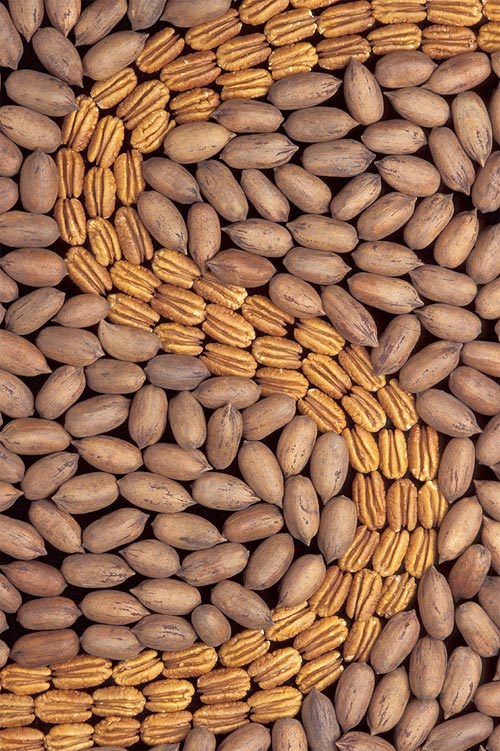
Pecan industry at crossroads
Pecan harvest is under way.Promises of excellent off-year yields from producers in the nation’s Pecan Belt.Challenge is to be able to meet the increasing demand, particularly export demand from China, while providing adequate supplies for domestic consumption.The overall supply is still down about 26.5 million pounds from last year.
October 11, 2010

Even with the pecan harvest under way and promises of excellent off-year yields from producers in the nation’s Pecan Belt, the pecan industry is at a crossroads, according to a Texas AgriLife Extension Service economist.
“The pecan harvest in Texas began recently and continues to gain momentum,” said Jose Pena, AgriLife Extension economist-management at the Texas AgriLife Research and Extension Center in Uvalde. “But while it’s seeing above-average crop production throughout the Pecan Belt this year, the U.S. pecan industry has a serious challenge that needs to be addressed. Right now, it is at a crossroads.”
Pena said the industry’s challenge is to be able to meet the increasing demand for pecans, particularly export demand from China, while continuing to provide adequate supplies for domestic consumption.
“The Oct. 8 official U.S. Department of Agriculture estimate of the nation’s pecan crop at 271.3 million pounds is just 20.5 million pounds lower than 292 produced last year,” Pena said. “Together with the estimates of ‘carry-in’ pecan supplies at about 92 million pounds, this would make the estimate of available pecans at about 363.3 million pounds.
“But even though this reflects above-average production, especially for an off year, the overall supply is still down about 26.5 million pounds from last year.”
Pena added that pecan imports from Mexico also will be less than last year since 2010 is similarly an off year for pecan production there, and this will further lower the aggregate supply of pecans available.
“Also, even with good overall growing conditions over most of the pecan belt during the past year, many producers still experienced lower-than-average yields due to crop stress this summer,” he said.
But in spite of some summer stress, pecan production for Texas this season appears to be excellent, said AgriLife Extension horticulturist Larry Stein.
“We’re expecting to have an above-average yield and very good nut quality this year,” said Tim Montz, owner of Montz Pecan.
Montz plants on about 1,000 acres of irrigated, improved and non-irrigated orchard land in north central Texas near Wichita Falls. Although one of his orchards was badly damaged by hail, the remainder of his orchards produced well and compensated for the loss. Last year was the first year Montz Pecan conducted business with China.
“(In 2009) Chinese buyers bought about 25 percent of my crop,” Montz said. “And this year, I’ve already gotten lots of calls (from prospective buyers) and am seeing a good amount of interest in this crop. I expect to do as much or more business with China this year as last.”
“In 2009, between 80 million and 100 million pounds of U.S. pecans were shipped to China,” said Cindy Wise, executive vice president of the Texas Pecan Growers Association. That was about 25 percent of the entire pecan production of both the U.S and Mexico, and some of that supply carried over into cold storage.”
Wise said China’s near-term demand would largely depend on what portion of that supply has been used up now and how much will be used during January’s Lunar New Year celebrations.
“China has major celebrations in September and January, during which many pecans are used and consumed,” she said.
Wise explained that a major reason exportation to China has been a boon for pecan growers is Chinese buyers typically purchase the product in-shell.
“The Chinese usually buy directly from the grower and require they provide them with larger in-shell nuts, so the product usually doesn’t go through the shelling process before it’s exported.”
Pena, however, expressed his concern that exportation of premium pecans to other countries makes fewer high-quality pecans available to U.S. consumers and “applies upward pricing pressure” on pecans used for domestic consumption.
“It’s a matter of the industry finding the right balance between domestic and export demand and working to ensure there are adequate supplies of quality pecans to meet both,” he said. Wise noted that while exports to China more directly benefit the larger growers who sell to them, they also provide a benefit to smaller growers.
“The pecan market has been strong for the past several years and producers will continue to receive higher prices for their product,” she said. “It’s also likely that prices paid to growers this year will be the highest they’ve ever been.”
Pena said he hopes the U.S. pecan industry will be able to continue to meet the growing demand for its product and that American consumers will continue to have access to high-quality pecans.
You May Also Like



